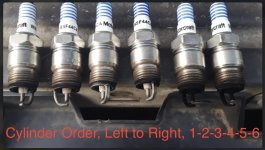You are using an out of date browser. It may not display this or other websites correctly.
You should upgrade or use an alternative browser.
You should upgrade or use an alternative browser.
Troubles with blow by
- Thread starter Linear Six
- Start date
PSIG
Well-known member
The plugs require a well-lit magnifier or macro camera to read well, all the way to the bottom of the center ceramic. Complimentary info here and here.
How the plugs were used at the moment of engine shutdown is critical to the information they can provide. For example, if reading plugs for wide-open, the engine should be run wide-open for as long as possible (full 1/4-mile or whatever you can do) for maximum coloring on clean plugs, then the engine cleanly shut-down from that condition. Or, idle reading done after several minutes of fully-warmed idling and shut-down from that condition, and so on. In each case, clean plugs must be used to see the coloring and indicators.
Clean plugs, with clean shutdown from reading condition. I use several sets of plugs in a full tune for clear, good readings. There is no waste, as they are shelved for later replacement use. Cheap on-sale plugs are fine for initial tuning, to get into the ball park. Your plugs appear to have seen low-load/idle before shutdown, else the oil and carbon would have burned-off (assuming optimal tuning) -or- your high-load tuning is excessively rich on some cylinders and oil is heavy enough to have not burned-off. Notice the concerns or confusion that pop-up if the plugs are not read for the condition.
On the surface, I see no obvious signs of detonation. Mixture is questionable with mixed use, but not horrible in any general sense. Plug 1 appears to have a gasket leak. Perhaps installation torque. Plug 5 is a combination of fuel and oil fouling. Plug 6 has more sheen, and appears to be more oil fouling. Timing is again difficult with mixed use, but appears between optimal to slightly over-advanced in certain unknown areas. Heat range is OK to a bit cold (don't change that yet!), again not knowing conditions for the read. All-in-all, not bad, and limiting oil to the rear plugs would help generally, with some fresh new reads to confirm specific operating areas.
Mixture is questionable with mixed use, but not horrible in any general sense. Plug 1 appears to have a gasket leak. Perhaps installation torque. Plug 5 is a combination of fuel and oil fouling. Plug 6 has more sheen, and appears to be more oil fouling. Timing is again difficult with mixed use, but appears between optimal to slightly over-advanced in certain unknown areas. Heat range is OK to a bit cold (don't change that yet!), again not knowing conditions for the read. All-in-all, not bad, and limiting oil to the rear plugs would help generally, with some fresh new reads to confirm specific operating areas.
As previously mentioned, purging the vapors overboard (instead of through PCV and into the engine) temporarily could help confirm the oil source and conditions for it. The ECM should compensate for that condition, but keep an eye on the tune for it. Hope that helps.
[EDIT] Check your catch can baffling. If minimal, you might consider stuffing more material in (commonly stainless steel or copper dish scrubber pads), or adding a large paper element filter after the catch can to help remove vapor mist or particles.
How the plugs were used at the moment of engine shutdown is critical to the information they can provide. For example, if reading plugs for wide-open, the engine should be run wide-open for as long as possible (full 1/4-mile or whatever you can do) for maximum coloring on clean plugs, then the engine cleanly shut-down from that condition. Or, idle reading done after several minutes of fully-warmed idling and shut-down from that condition, and so on. In each case, clean plugs must be used to see the coloring and indicators.
Clean plugs, with clean shutdown from reading condition. I use several sets of plugs in a full tune for clear, good readings. There is no waste, as they are shelved for later replacement use. Cheap on-sale plugs are fine for initial tuning, to get into the ball park. Your plugs appear to have seen low-load/idle before shutdown, else the oil and carbon would have burned-off (assuming optimal tuning) -or- your high-load tuning is excessively rich on some cylinders and oil is heavy enough to have not burned-off. Notice the concerns or confusion that pop-up if the plugs are not read for the condition.
On the surface, I see no obvious signs of detonation.
As previously mentioned, purging the vapors overboard (instead of through PCV and into the engine) temporarily could help confirm the oil source and conditions for it. The ECM should compensate for that condition, but keep an eye on the tune for it. Hope that helps.
[EDIT] Check your catch can baffling. If minimal, you might consider stuffing more material in (commonly stainless steel or copper dish scrubber pads), or adding a large paper element filter after the catch can to help remove vapor mist or particles.
Linear Six
I ran a Holley Sniper 2300 on the 300 for a while. When I bought my unit, Holley had quality issues on some of the 2300’s being produced. On the original unit I purchased, and the replacement. The annular discharge nozzle closest to the throttle lever side were improperly installed and in turn was dumping excessive amounts of fuel in the manifold. The fuel was literally spraying out of the throttle body. Its something to check out.
If I remember, the manifold you’re using has the runner pitching downward parallel with the engine. The manifold is not level with the ground. You could be experiencing some of what I went through with un-vaporized fuel running down the runner to cylinders 5 & 6 on cooler days. This problem would not happen on very warm and hot days.
I lived with the problem of fuel flooding cylinders 5 & 6 for months until the Offenhauser C manifold was heated to 195 degrees by the engine coolant.
Here is a picture of the plugs would look like on a cool day before the manifold was heated:

The Offenhauser C manifold runner is pitched pretty much like yours is. I’m thinking that it might help you by installing a heating pad under the plenum of your manifold.
I believe Ford leveled the intake manifold runner and “exhaust heated” the intake manifold on a stock engine for a reason. You could try heating your manifold and see if it helps.
The nice thing about the intake manifold you’re using is, bosses are casted on it. And the manifold can be machined and set up for port injection.
About blowby:
Are cylinders 5 & 6 leaking down faster than others?
It’s possible that cylinders 5 & 6 are being washed down by gas. This could possibly damage rings and/or cylinders. The reason why I’m bringing this up is, before the Offenhauser C manifold was heated on my engine, the oil in my engine was diluted by lots of gas. Had to do oil changes very frequently during the cold weather. I believe around 1,000 miles.
I ran a Holley Sniper 2300 on the 300 for a while. When I bought my unit, Holley had quality issues on some of the 2300’s being produced. On the original unit I purchased, and the replacement. The annular discharge nozzle closest to the throttle lever side were improperly installed and in turn was dumping excessive amounts of fuel in the manifold. The fuel was literally spraying out of the throttle body. Its something to check out.
If I remember, the manifold you’re using has the runner pitching downward parallel with the engine. The manifold is not level with the ground. You could be experiencing some of what I went through with un-vaporized fuel running down the runner to cylinders 5 & 6 on cooler days. This problem would not happen on very warm and hot days.
I lived with the problem of fuel flooding cylinders 5 & 6 for months until the Offenhauser C manifold was heated to 195 degrees by the engine coolant.
Here is a picture of the plugs would look like on a cool day before the manifold was heated:

The Offenhauser C manifold runner is pitched pretty much like yours is. I’m thinking that it might help you by installing a heating pad under the plenum of your manifold.
I believe Ford leveled the intake manifold runner and “exhaust heated” the intake manifold on a stock engine for a reason. You could try heating your manifold and see if it helps.
The nice thing about the intake manifold you’re using is, bosses are casted on it. And the manifold can be machined and set up for port injection.
About blowby:
Are cylinders 5 & 6 leaking down faster than others?
It’s possible that cylinders 5 & 6 are being washed down by gas. This could possibly damage rings and/or cylinders. The reason why I’m bringing this up is, before the Offenhauser C manifold was heated on my engine, the oil in my engine was diluted by lots of gas. Had to do oil changes very frequently during the cold weather. I believe around 1,000 miles.
Last edited:
Linear Six
Well-known member
Not sure if you can see the picture, this cylinder 3. All are similar. I can easily see the cross hatch and then I can see a few faint vertical scores.Detonation can also appear as blue/gray exhaust smoke as the shockwave blasts oil off the cylinder walls and burns it. I would read your spark plugs for all signs (fuel, timing, det, heat range, etc). Stick an endoscope in each cylinder spark plug hole to check piston and cylinder wall condition (especially scoring from butting rings) and general health. The leak-down does not indicate serious damage, so it's a quick verification of signs and indicators.
Where do you have your fresh air crankcase inlet? Typically, the PCV is to the manifold or spacer, and when it seals from positive boost pressure, crankcase vapor escapes through the fresh air crankcase inlet. While this fresh air is commonly from the air filter housing, it is common to add a catch can on the fresh air line to separate oil blowing at boost pressure to the air filter housing. Preferably, both the air inlet and PCV outlet are baffled in the valve cover for boost apps, to help contain oil mist.
There are other systems and schemes, so if that's not yours, please describe what you have.
Attachments
Linear Six
Well-known member
I'm going to consider new rings fitted for boosted application. Does anyone have any recommended manufacture for rings and forged pistons?
thanks
thanks
aussie7mains
Famous Member
Sounds like the oil is coming through the blower, check the seals.
Linear Six
Well-known member
Blower is new and found no residual oil on duct from blower to carb.
Call Autotec/Racetec and DSSI'm going to consider new rings fitted for boosted application. Does anyone have any recommended manufacture for rings and forged pistons?


